Table of contents
- Comparison test: Honda CBF 1000 Silverline, Suzuki Bandit 1250 S, Yamaha FZ1 Fazer All-rounder with touring equipment
- Travel qualities
- Curve scratches
- All-rounder talents
- MOTORCYCLE scoring
- Data Honda CBF 1000 Silverline
- Data Suzuki Bandit 1250 S.
- Data Yamaha FZ1 Fazer
- MOTORCYCLE touring ranking
- MOTORCYCLE measurements
- MOTORCYCLE test result
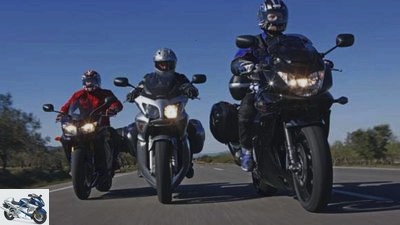
Jahn
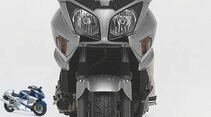
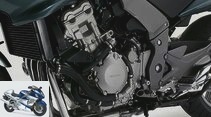
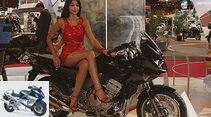
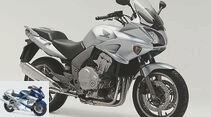
22nd pictures
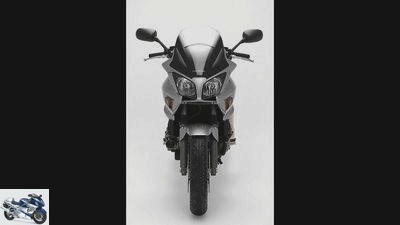
Honda
1/22
Honda CBF 1000
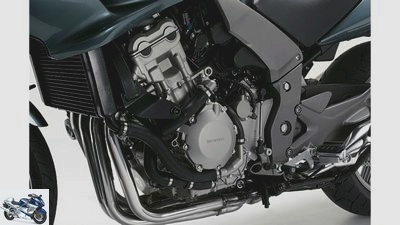
Honda
2/22
Honda CBF 1000
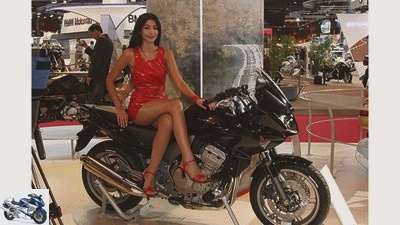
Zdrahal
3/22
Presentation at the fair in Paris.
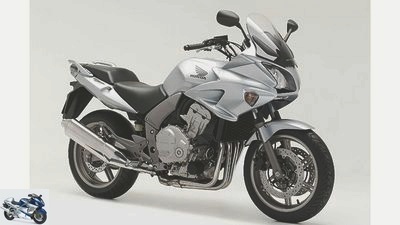
Honda
4/22
Honda CBF 1000

Honda
5/22
Honda CBF 1000

Honda
6/22
Honda CBF 1000
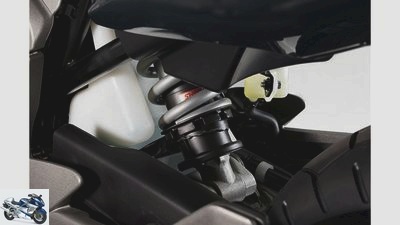
Honda
7/22
Honda CBF 1000
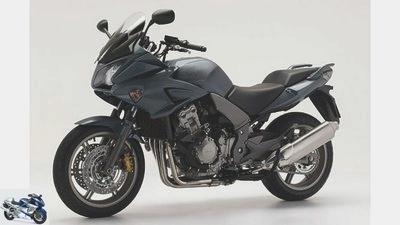
Honda
8/22
Honda CBF 1000
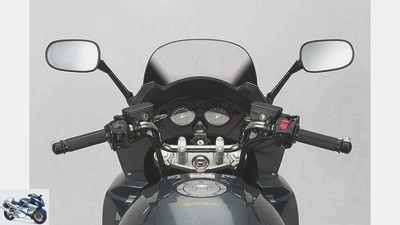
Honda
9/22
Honda CBF 1000
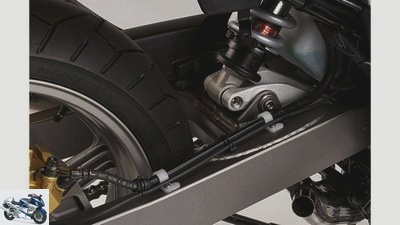
Honda
10/22
Honda CBF 1000

Honda
11/22
Honda CBF 1000
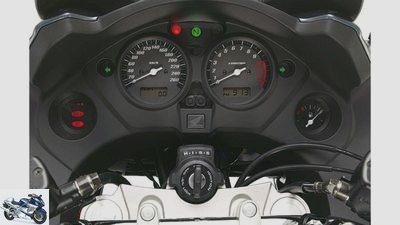
Honda
12/22
Honda CBF 1000
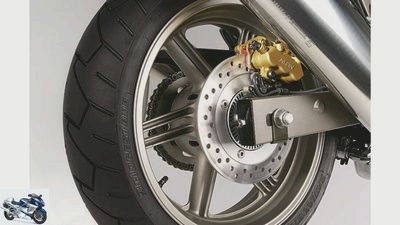
Honda
13/22
Honda CBF 1000
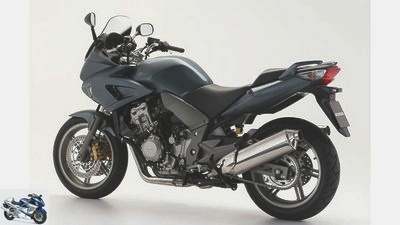
Honda
14/22
Honda CBF 1000
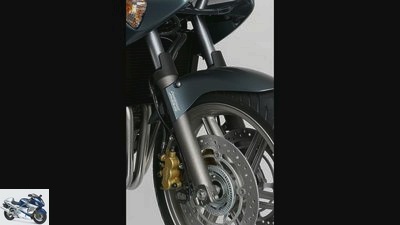
Honda
15/22
Honda CBF 1000
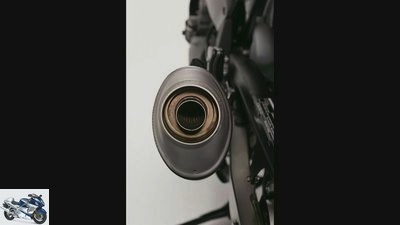
Honda
16/22
Honda CBF 1000
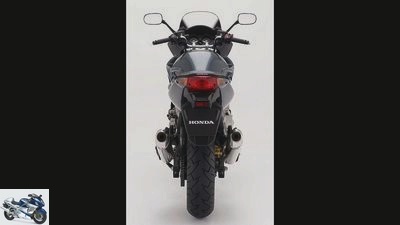
Honda
17/22
Honda CBF 1000
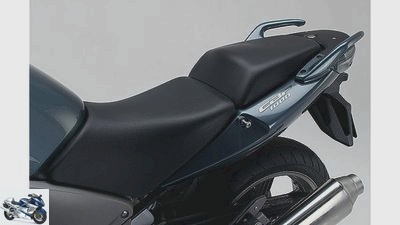
Honda
18/22
Honda CBF 1000
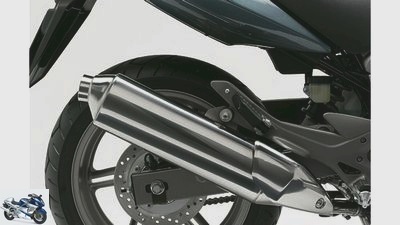
Honda
19/22
Honda CBF 1000

Honda
20/22
Honda CBF 1000
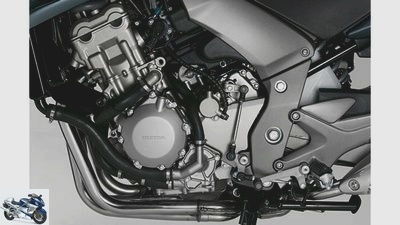
Honda
21/22
Honda CBF 1000

Humke
22/22
motorcycles
Comparison test: Honda CBF 1000 Silverline, Suzuki Bandit 1250 S, Yamaha FZ1 Fazer
Comparison test: Honda CBF 1000 Silverline, Suzuki Bandit 1250 S, Yamaha FZ1 Fazer
All-rounder with touring equipment
As the name suggests: All-rounders should be able to do everything. Heating, cruising, hiking and also touring. Even with a bag and bag. Right?
Peter Mayer
03/27/2008
The old shepherd looks at us blankly. Menos viento? Less wind? In the region of Barcelona, creo. In the Barcelona area. Does he believe? and crawls a little deeper behind the collar of his felt coat from the stiff breeze. With that he signals the end of the local weather advice ?? and probably also what he thinks of us at this moment: unfortunate lunatics. Two hours later we are grateful to the taciturn shepherd for this advice, we are sitting in a street cafe near Barcelona. Another world. We have left the icy Tramontana behind us, which in Tarragona imposed frightening inclines even when driving straight ahead. At last you can feel the Spanish spring, the lush green of the meadows can arouse anticipation for the start of the motorcycle season north of the Pyrenees and the Alps.
Buy complete article
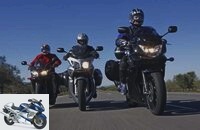
Comparison test: Honda CBF 1000 Silverline, Suzuki Bandit 1250 S, Yamaha FZ1 Fazer
All-rounder with touring equipment
11 pages) as PDF
€ 2.00
Buy now
After all, we are well prepared: prepared for the big tour for little money. At least that’s what three of the currently best-selling all-rounders want to prove to us. Want to demonstrate that comfortable travel is not only possible with luxury liners à la Honda Pan European and Co. from 15,000 euros. For the first time for the 2008 season, Honda is offering the top-selling CBF 1000 in the so-called Silverline Edition with cases and lower fairing. Surcharge compared to the standard version: 990 euros. Suzuki is not planning a special touring model for its top seller in the all-rounder segment, the Bandit 1250 S, but instead offers cases, top cases, cladding extensions and a higher shield for 1495 euros from its own range of accessories. GT called itself the travel edition of the Yamaha FZ1 Fazer last season. This year, Yamaha no longer offers the combination offer, leaving the customer to upgrade with suitcases and lower fairing for a total of 1779 euros.
The sun’s rays have long since heated us up, and the warmth returns to our chilled fingers. How often have you seen this on the weekend trip to Italy or the early bird tour in the Vosges or Ardennes. And realized that the fun of motorcycling is by no means defined solely by lean angles or sheer power. Found that after a few hundred kilometers on the clock, the motorcycle world changes. One in which more rational values count: relaxed seating position, good draft and sensible wind protection. Or that the pillion can still hold out on their seat after a few hours.
Travel qualities
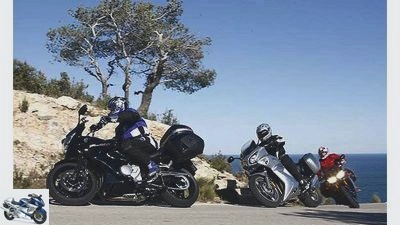
Jahn
Trio on tour: Honda CBF 1000 Silverline, Suzuki Bandit 1250 S and Yamaha FZ1 Fazer.
La cuenta, por favor ?? The check, please. The area here attracts with moderate traffic, winding streets and the best asphalt. In fact, with the big bikes, it swings so casually from curve to curve straight away, as if the economy tourers wanted to convince with their qualities from the first meter. After all, they boast one of the most important ingredients for a decent travel vehicle: sufficient displacement. In the case of the Honda and Yamaha, they are of the finest provenance. After all, it is the four-cylinder of the 1000 Fireblade or the R1 that babble in the Honda CBF and the Yamaha Fazer. Although not the very latest, both units come from the 2006 editions of the Sportbikes. Proven means such as reduced compression, tamer valve timing, smaller intake ports (only Honda) and larger crankshaft flywheel mass (only Yamaha) help to open up the brilliant power output of the athletes for soft tourism. Suzuki is approaching this project even more consistently, pouring a quarter liter more displacement with the large Bandit presented in 2007.
Which is already noticeable on the first turns. Superior pressure from below, that is the domain of the 1250 bandit. The four-wheeler, which is now water- instead of air- / oil-cooled, pushes powerfully from as little as 2000 rpm, rolling everything flat with its huge mountain of torque between 3000 and 6000 revolutions. The competition has no chance. The Honda pulls out of the affair vis-à-vis the bandit. Clearly inferior to the pure torque measured values, the CBF motor convinces with its unspectacular manner of appearance. Without much fuss, almost like an electric motor, it releases its power from idle speed, effectively pushing horse and rider forward after every bend. Few of the engine characteristics convey the exhilaration of touring as modestly and yet as impressively as the Honda four-cylinder.
A discipline in which the Yamaha still has to find itself. Because the numerical superiority of measured 148 PS ?? after all, a stately 47 hp more than the Honda and their 40 more than the Suzuki ?? cannot use the Fazer in their favor. Especially in the speed range relevant to country roads, i.e. between 3000 and 6000 tours, the short-stroke doesn’t really want to get into pottery. And by no means only under the undoubtedly often exaggerated standards that are placed on this type of high-performance four-cylinder. No, the FZ1 only fulfills the desire for moderate touring pressure from the lower engine speed range from 4000 rpm. Even then, remain hesitant for a long time to yourself ?? way too late for the touristic ride ?? only to excuse this faux pas with a brilliant acceleration fireworks at 7000 rpm.
Curve scratches
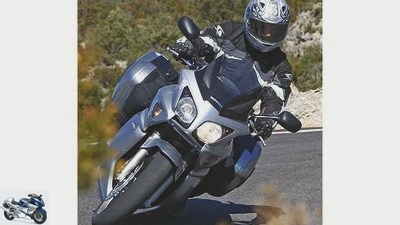
Jahn
The Honda scores not only with its case and carrier system.
The curve band gradually stretches out into smooth terrain. Only then can this super sporty, speed-oriented orientation of the FZ1 engine be understood. Because this sporty touch runs through the Fazer from front to back. The fully adjustable upside-down fork, the matt black coated aluminum bridge frame, the cantilever swing arm made of cast aluminum, the finely contoured engine cover ?? the Yamaha offers something for the eye, appears significantly more valuable than its two colleagues. It should too, with a price difference of two and a half thousand. The seating position is also sporty. Leaning forward slightly, the straight Streetfighter handlebar grips itself comfortably. Only the knee closure around the massive frame profile forces an initially uncomfortably wide balancing act. And yet it fits the character of the Yamaha. The direct steering feel, the tight suspension set-up, the excellent straight-line stability, all of this conveys tremendous confidence. Can even be forgiven for the more sluggish handling due to the 190 rear tire without ultimately covering up the fact: The Fazer is and will remain a sport bike? also in touring regalia.
What the CBF 1000 probably never wanted to be. Although she is also consistent in her own way. Meekness and suppleness run through the CBF from the handlebars to the rear axle ?? just like the trail of the red pencil. And yet for the profane steel swing arm, the plastic panel on the frame flank that suggests an aluminum chassis, or for the spring elements that can only be adjusted in the preload of the shock absorber, a barely audible sigh, because the result fits. The suspension set-up is comfortable for tourists, and the seating position with high handlebars and low seat is correspondingly cozy. Nothing for the speed rush on country roads, for that? also thanks to the unusually narrow 160 mm rear tire ?? CBF is the handiest of the three there. Great: Both the handlebar position and the seat height can be adjusted to the driver’s size.
A coherence of the concept that, by the way, also applies to the Suzuki. With her, the beefy nature of the engine is reflected in the entire motorcycle. The suspension set-up is sporty and firm, hits exactly the middle between Honda and Yamaha and shows itself to be an ideal compromise with reasonable comfort and good roadholding. Just like the slightly higher seating position compared to the Honda, which allows both leaning back cruising and dashing curve scraping ?? and can also be adjusted in two heights. On the subject of handling: Here too, the Bandit offers the perfect middle ground. The 180 mm rear tire is appropriate for the 108 hp and still remains within acceptable limits in terms of pitching tendency when braking.
All-rounder talents
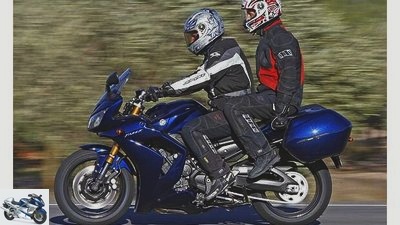
Jahn
Praise be for what makes you hard? Sharp knee angles and hard upholstery await the passenger on the Fazer.
The road is completely straight and becomes a high-speed route. For a few kilometers we ignore the manufacturer’s recommendation to be content with suitcases with a top speed of 130 km / h. Only the Honda can occasionally be stimulated into harmless commuting when doing over 160 things with bumps in the road, the Bandit and the Yamaha remain steadfastly on course. The Suzuki also pleases with the most effective wind protection, the adjustable vario touring screen from MRA. Even tall drivers remain completely in the slipstream when the attachment is completely unfolded, while things are still quite turbulent behind the CBF’s shield mounted in the highest position. Only experience from previous tests will help to explore the potential of the Yamaha windshield. Only the higher retrofit disc of the Fazer ?? the low original shield was installed on the test machine ?? brings the Yamsel to CBF level in this regard. By the way: The lower fairing parts have to surrender when it comes to wind and weather protection on all three machines, which specialized tourers can do much better.
Gas out, refuel. With 6.5 liters per 100 kilometers, the Yamaha sucks in one liter more fuel than the Honda and Suzuki at a brisk pace. Nevertheless, it is easy to live with a range of over 300 kilometers. Which may not necessarily apply to the backbenchers. Their sympathies clearly belong to the Honda. An open knee angle and sufficient space on the back bench ensure potential family peace. The voluminous exhaust of the Suzuki forces footpegs to be installed just as high as that of the Yamaha, which however ?? very sportswoman ?? offers the most spartan seating. To make matters worse, the Fazer only allows light-weight passengers with a meager 170 kilograms payload. But more amazed how much the pillion passenger and luggage influence the performance. Suddenly, despite the three-digit horsepower figures, the three of them need a good 50 percent longer for the practically relevant pull-through from 60 to 140 km / h in last gear. While the precisely translated Honda doesn’t give the bandit a chance in this regard, the strong but exaggeratedly long translated Yamaha really has to be demonstrated. One consolation: none anchors as vehemently as the Yamaha. With the monoblock pliers, one finger is enough for force braking. Noticeably inconspicuous? How could it be otherwise ?? grabs the Honda composite brake system. The Suzuki stoppers require significantly more hand strength. All three can rely on well-coordinated ABS systems. Great thing.
It is in the nature of things that all-rounders, who by definition are supposed to cover as wide a range of possible uses as possible, differ from one another in their respective focus. In this respect it is understandable that the nobly processed, high-quality equipped and powerful Yamaha in the totality of all aspects ?? which ultimately reflects the MOTORRAD 1000 point evaluation? has the fairing nose at the front. Only when the weighting shifts? for example to the tourism aspects chosen as the focus in this comparison ?? more specialized qualities come to the fore. And there the Yamaha blows a strong wind into the sleek, styled face.
MOTORCYCLE scoring
engine
The strength of the Yamaha engine is its strength. 148 hp is a word compared to the competition. Even the measured draft is okay? even if the subjective perception attests the Fazer drive a sluggish start. Great: the beefy character of the bandit engine. Despite the weakest engine, the Honda shines with a perfect gear ratio and smooth load changes.
Winner engine: Yamaha
landing gear
Quality is convincing. It can be seen that the red pencil usually stayed in the drawer at Yamaha. Spring elements, aluminum frames and workmanship are well above the level of the competition. They are in a head-to-head race in different ways. The CBF relies on agile handling and comfortable suspension, the Bandit counteracts this with spring reserves and stability.
Winner chassis: Yamaha
everyday
Now is the time for reason bikes. While the Yamaha loses terrain with its unfamiliar load limit and a sporty seating position, the CBF and Bandit shine with a comfortable seating position and acceptable wind protection. Long range and ample payload narrowly give the Suzuki victory. However: Especially with her, the passenger comfort should be more pronounced.
Winner everyday: Suzuki
security
ABS is no longer an issue for all-rounders. With all three you can rely on a very well coordinated anti-lock braking system. Nevertheless: The brakes of the Fazer stand out in the test field with their excellent effectiveness and controllability.
Winner security: Yamaha
costs
Ultimately, the road usage decides in favor of the bandit. A clear disadvantage: the high price of the Fazer.
Winner cost: Honda / Suzuki
Winner price-performance: Honda
If the score is tied, the Honda secures victory with a two-point lead.
Data Honda CBF 1000 Silverline
engine
Water-cooled four-cylinder four-stroke in-line engine, two overhead, chain-driven camshafts, four valves per cylinder, bucket tappets, wet sump lubrication, injection, Ø 36 mm, regulated catalytic converter, alternator 344 W, battery 12 V / 9 Ah, hydraulically operated multi-disk oil? Oil clutch, six-speed gearbox, O-ring chain, secondary ratio 43:16.
Bore x stroke 75.0 x 56.5 mm
Cubic capacity 998 cm³
Compression ratio 11: 1
Rated output 72.0 kW (98 PS) at 8000 rpm
Max. Torque 93 Nm at 6500 rpm
landing gear
Bridge frame made of steel, telescopic fork, Ø 41 mm, two-arm swing arm made of steel, central spring strut with lever system, adjustable spring base, double disc brake at the front, Ø 296 mm, three-piston floating caliper, rear disc brake, Ø 240, three-piston floating caliper, composite brake system, ABS.
Cast aluminum wheels 3.50 x 17; 5.00 x 17
Tires 120/70 ZR 17; 160/60 ZR 17
Tires in the Michelin Pilot Road test, front “B”, rear “A”
mass and weight
Wheelbase 1480 mm, steering head angle 64.0 degrees, caster 110 mm, spring travel f / h 120/120 mm, weight with a full tank * 267 kg, payload * 178 kg, tank capacity 19.0 liters.
Warranty: two years
Service intervals every: 6000 km
silver
Price: 9,380 euros
Price test motorcycle: 10,080 euros
Additional costs: 200 euros
Data Suzuki Bandit 1250 S.
<!– ESI FOR ads.BannerGallery / irelements / esielement / eyJwYWdlIjoiL3N0YXJ0c2VpdGUvIiwibGF5b3V0IjoiYXJ0aWNsZSIsImVsZW1lbnQiOiJhZHMuQmFubmVyR2FsbGVyeSIsImlyQ29uZmlnIjoiMTQ3MjU1NzIiLCJwYXJhbXMiOnt9LCJpc01vYmlsZSI6ZmFsc2V9 –> <!– CACHEABLE –>&# 34;,&# 34; rectangle&# 34 ;: “<!–# include virtual = \&# 34 / irelements / esielement / eyJwYWdlIjoiL3N0YXJ0c2VpdGUvIiwibGF5b3V0IjoiYXJ0aWNsZSIsImVsZW1lbnQiOiJhZHMuUmVjdGFuZ2xlR2FsbGVyeSIsImlyQ29uZmlnIjoiMTQ3MjU1NzIiLCJwYXJhbXMiOnt9LCJpc01vYmlsZSI6ZmFsc2V9 \&# 34; –> <!– ESI FOR ads.RectangleGallery / irelements / esielement / eyJwYWdlIjoiL3N0YXJ0c2VpdGUvIiwibGF5b3V0IjoiYXJ0aWNsZSIsImVsZW1lbnQiOiJhZHMuUmVjdGFuZ2xlR2FsbGVyeSIsImlyQ29uZmlnIjoiMTQ3MjU1NzIiLCJwYXJhbXMiOnt9LCJpc01vYmlsZSI6ZmFsc2V9 –> <!– CACHEABLE –>&# 34;,&# 34; sky&# 34 ;: “<!–# include virtual = \&# 34 / irelements / esielement / eyJwYWdlIjoiL3N0YXJ0c2VpdGUvIiwibGF5b3V0IjoiYXJ0aWNsZSIsImVsZW1lbnQiOiJhZHMuU2t5R2FsbGVyeSIsImlyQ29uZmlnIjoiMTQ3MjU1NzIiLCJwYXJhbXMiOnt9LCJpc01vYmlsZSI6ZmFsc2V9 \&# 34; –> <!– ESI FOR ads.SkyGallery / irelements / esielement / eyJwYWdlIjoiL3N0YXJ0c2VpdGUvIiwibGF5b3V0IjoiYXJ0aWNsZSIsImVsZW1lbnQiOiJhZHMuU2t5R2FsbGVyeSIsImlyQ29uZmlnIjoiMTQ3MjU1NzIiLCJwYXJhbXMiOnt9LCJpc01vYmlsZSI6ZmFsc2V9 –> <!– CACHEABLE –>&# 34;}}” ga-track-vis =”article.gallery.inline.vis” class =”v-A_-article__inline-container”>
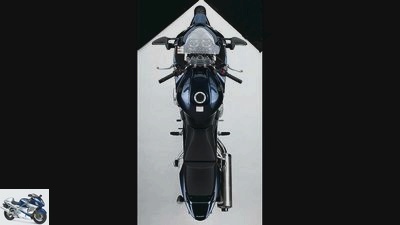
Suzuki




20th pictures
Pictures: Comparison test: Honda CBF 1000 Silverline, Suzuki Bandit 1250 S, Yamaha FZ1 Fazer
go to Article
To home page
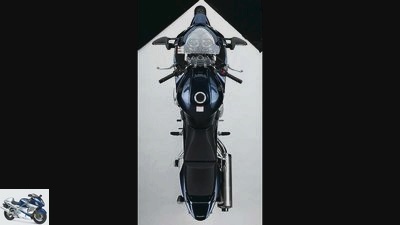
Suzuki
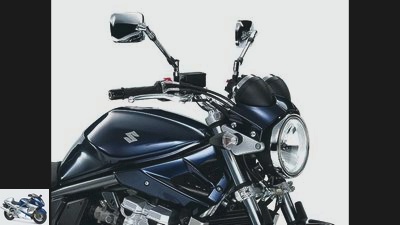
Suzuki
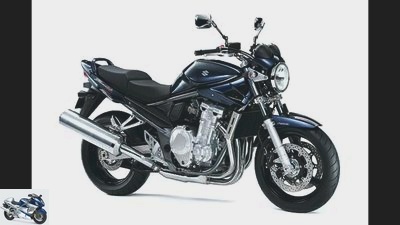
Suzuki
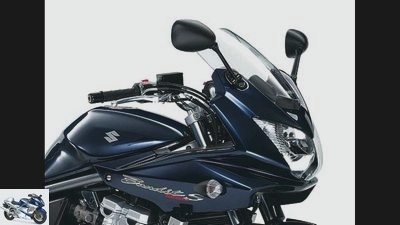
Suzuki
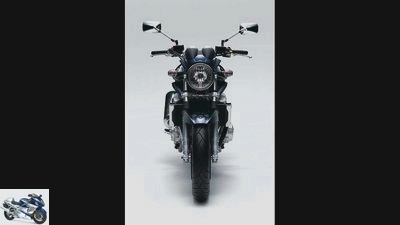
Suzuki
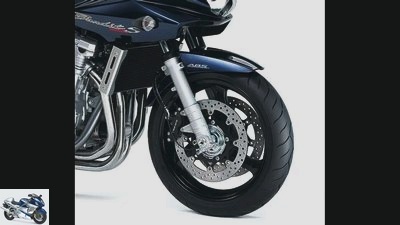
Suzuki
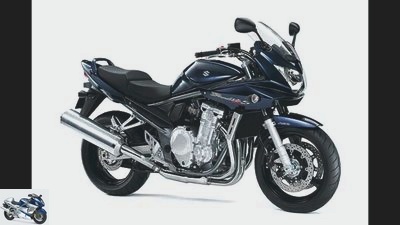
Suzuki
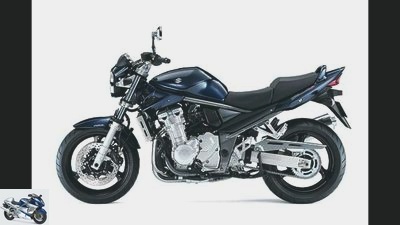
Suzuki
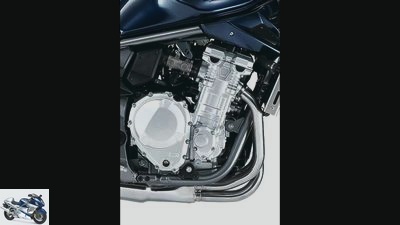
Suzuki

Suzuki
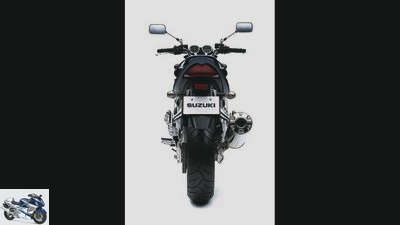
Suzuki
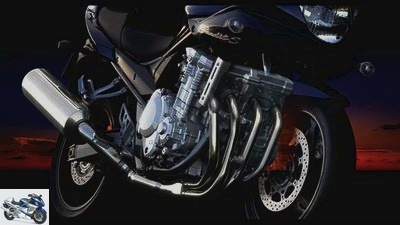
Suzuki
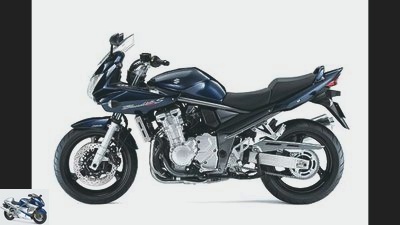
Suzuki
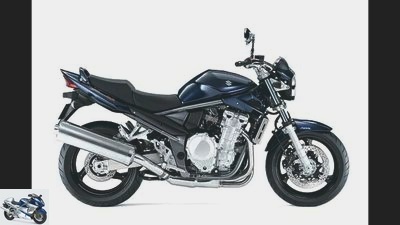
Suzuki
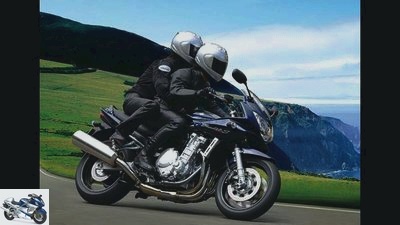
Suzuki

Suzuki
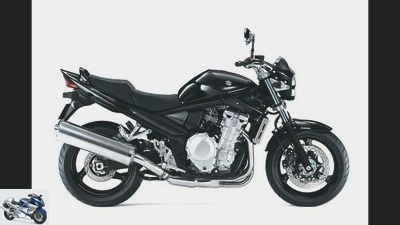
Suzuki

Suzuki
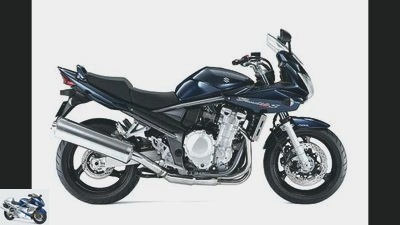
Suzuki
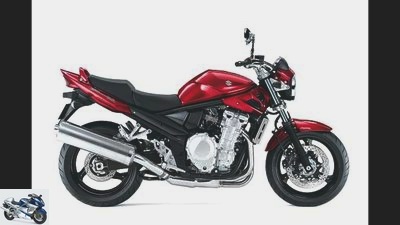
Suzuki
1/20
engine
Water-cooled four-cylinder four-stroke in-line engine, two overhead, chain-driven camshafts, four valves per cylinder, bucket tappets, wet sump lubrication, injection, Ø 36 mm, regulated catalytic converter with secondary air system, 400 W alternator, 12 V / 10 Ah battery, hydraulically operated multi-disc oil bath clutch , Six-speed gearbox, O-ring chain, secondary ratio 43:18.
Bore x stroke 79.0 x 64.0 mm
Cubic capacity 1255 cm³
Compression ratio 10.5: 1
Rated output 72.0 kW (98 PS) at 7500 rpm
Max. Torque 108 Nm at 3700 rpm
landing gear
Double loop frame made of steel, telescopic fork, Ø 43 mm, adjustable spring base, two-arm swing arm made of aluminum, central spring strut with lever system, adjustable spring base and rebound damping, double disc brake at the front, Ø 310 mm, four-piston fixed calipers, disc brake at the rear, Ø 240, single-piston floating caliper, ABS.
Cast aluminum wheels 3.50 x 17; 5.50 x 17
Tires 120/70 ZR 17; 180/55 ZR 17
Tires in the test Dunlop D 218, front “T”, rear “N”
mass and weight
Wheelbase 1485 mm, steering head angle 64.7 degrees, caster 104 mm, spring travel f / r 130/136 mm, seat height * 785 805 mm, weight with a full tank * 274 kg, payload * 201 kg, tank capacity 19.0 liters.
Warranty: two years
Service intervals every: 6000 km
Colors: red, blue, black
Price: 8590 euros
Price test motorcycle: 10 086 euros
Additional costs: 145 euros
Data Yamaha FZ1 Fazer
<!– ESI FOR ads.BannerGallery / irelements / esielement / eyJwYWdlIjoiL3N0YXJ0c2VpdGUvIiwibGF5b3V0IjoiYXJ0aWNsZSIsImVsZW1lbnQiOiJhZHMuQmFubmVyR2FsbGVyeSIsImlyQ29uZmlnIjoiMTQ3MjU1NzIiLCJwYXJhbXMiOnt9LCJpc01vYmlsZSI6ZmFsc2V9 –> <!– CACHEABLE –>&# 34;,&# 34; rectangle&# 34 ;: “<!–# include virtual = \&# 34 / irelements / esielement / eyJwYWdlIjoiL3N0YXJ0c2VpdGUvIiwibGF5b3V0IjoiYXJ0aWNsZSIsImVsZW1lbnQiOiJhZHMuUmVjdGFuZ2xlR2FsbGVyeSIsImlyQ29uZmlnIjoiMTQ3MjU1NzIiLCJwYXJhbXMiOnt9LCJpc01vYmlsZSI6ZmFsc2V9 \&# 34; –> <!– ESI FOR ads.RectangleGallery / irelements / esielement / eyJwYWdlIjoiL3N0YXJ0c2VpdGUvIiwibGF5b3V0IjoiYXJ0aWNsZSIsImVsZW1lbnQiOiJhZHMuUmVjdGFuZ2xlR2FsbGVyeSIsImlyQ29uZmlnIjoiMTQ3MjU1NzIiLCJwYXJhbXMiOnt9LCJpc01vYmlsZSI6ZmFsc2V9 –> <!– CACHEABLE –>&# 34;,&# 34; sky&# 34 ;: “<!–# include virtual = \&# 34 / irelements / esielement / eyJwYWdlIjoiL3N0YXJ0c2VpdGUvIiwibGF5b3V0IjoiYXJ0aWNsZSIsImVsZW1lbnQiOiJhZHMuU2t5R2FsbGVyeSIsImlyQ29uZmlnIjoiMTQ3MjU1NzIiLCJwYXJhbXMiOnt9LCJpc01vYmlsZSI6ZmFsc2V9 \&# 34; –> <!– ESI FOR ads.SkyGallery / irelements / esielement / eyJwYWdlIjoiL3N0YXJ0c2VpdGUvIiwibGF5b3V0IjoiYXJ0aWNsZSIsImVsZW1lbnQiOiJhZHMuU2t5R2FsbGVyeSIsImlyQ29uZmlnIjoiMTQ3MjU1NzIiLCJwYXJhbXMiOnt9LCJpc01vYmlsZSI6ZmFsc2V9 –> <!– CACHEABLE –>&# 34;}}” ga-track-vis =”article.gallery.inline.vis” class =”v-A_-article__inline-container”>

Yamaha




18th pictures
Pictures: Comparison test: Honda CBF 1000 Silverline, Suzuki Bandit 1250 S, Yamaha FZ1 Fazer
go to Article
To home page
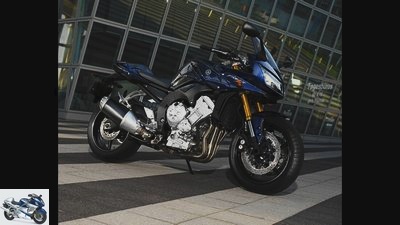
Yamaha
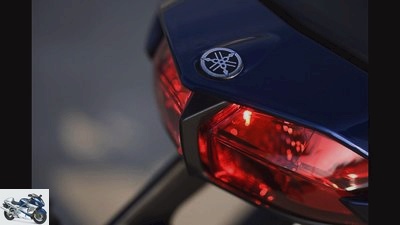
Yamaha
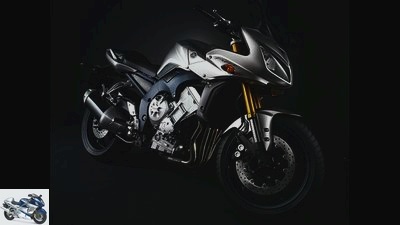
Yamaha
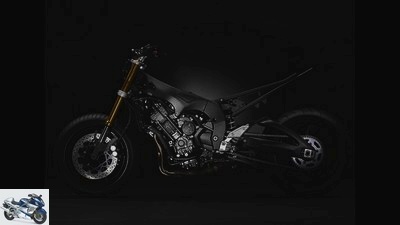
Yamaha

Yamaha
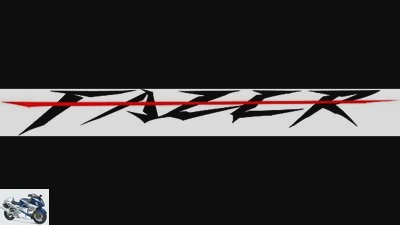
Yamaha
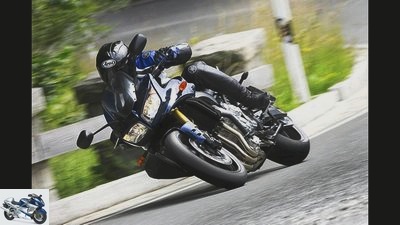
Yamaha

Yamaha

Yamaha
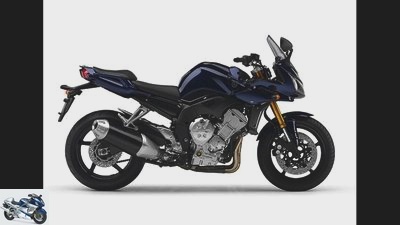
Yamaha
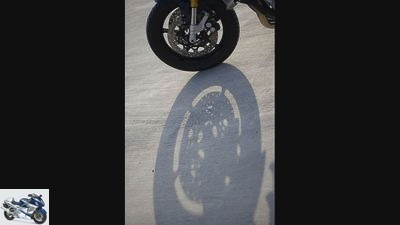
Yamaha

Yamaha
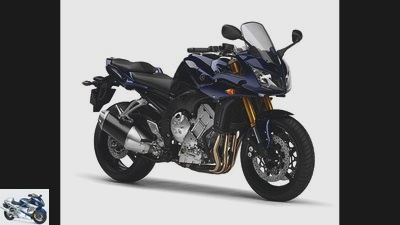
Yamaha
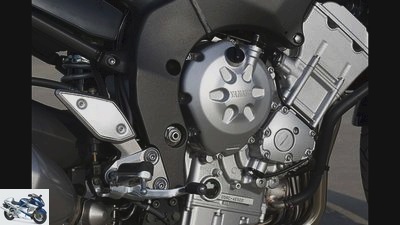
Yamaha
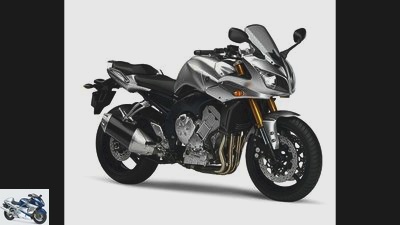
Yamaha

Yamaha
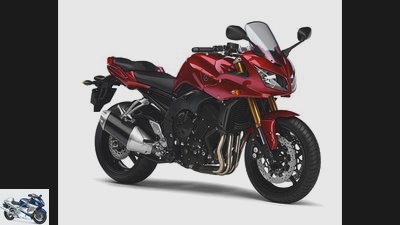
Yamaha
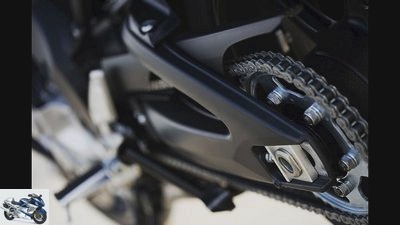
Yamaha
1/18
engine
Water-cooled four-cylinder four-stroke in-line engine, two overhead, chain-driven camshafts, five valves per cylinder, bucket tappets, wet sump lubrication, injection, Ø 42 mm, regulated catalytic converter, alternator 560 W, battery 12 V / 11 Ah, mechanically operated multi-plate oil bath clutch, Six-speed gearbox, O-ring chain, secondary ratio 45:17.
Bore x stroke 77.0 x 53.6 mm
Cubic capacity 998 cm³
Compression ratio 11.5: 1
Rated output 110.3 kW (150 PS) at 11,000 rpm
Max. Torque 106 Nm at 8000 rpm
landing gear
Bridge frame made of aluminum, upside-down fork, Ø 43 mm, adjustable spring base, rebound and compression damping, two-arm swing arm made of aluminum, central spring strut with lever system, adjustable spring base and rebound damping, front disc brake, Ø 320 mm, four-piston fixed calipers, rear disc brake, Ø 245, single-piston floating caliper, ABS.
Cast aluminum wheels 3.50 x 17; 6.00 x 17
Tires 120/70 ZR 17; 190/50 ZR 17
Tires in the test Dunlop D 221, front “A”, rear “G”
mass and weight
Wheelbase 1460 mm, steering head angle 65.0 degrees, caster 109 mm, spring travel f / h 130/130 mm, weight with a full tank * 240 kg, payload * 170 kg, tank capacity 18.0 liters.
Warranty: two years
Service intervals every: 10000 km
Colors: red, dark blue, gray
Price: 10650 euros
Price test motorcycle: 12,624 euros
Additional costs: 185 euros
MOTORCYCLE touring ranking
What is the best way to travel? The MOTORRAD touring rating only asks this single question and therefore deliberately excludes many other aspects with which the MOTORRAD 1000-point rating (see page 41) illuminates all facets of a model.
It is understandable that the placements in this special ranking can shift drastically? what they do in this test field. The bandit emerged as the clear winner for the travel group. The engine, which is powerful even at the lowest engine speeds, and the chassis set-up, which is compatible with passenger pillion without any compromises, give the Suzuki a solid lead over its toughest adversary, the CBF, in the sales statistics. It is not surprising that the sport-oriented Fazer is at the bottom in this regard.
MOTORCYCLE measurements
Two worlds collide: Yamaha makes hardly any compromises when it comes to the character of the four-cylinder. What counts is top performance, that’s it. Honda chooses exactly the opposite way, in comparison with the super-sporty origin of this engine in the Fireblade, dispenses with almost 70 hp, which is rewarded with an extremely homogeneous power output. Suzuki uses the capacity advantage of the 1255 engine for a mountain of torque that outclasses the competition between 3000 and 6000 rpm? and thus the basis for the victory of the Bandit in the tourer classification.
MOTORCYCLE test result
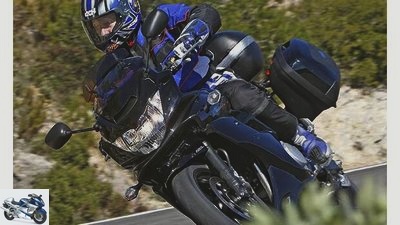
Jahn
Travel Hearts Winner: The Bandit knows what tourers want.
1st place:
Yamaha FZ1 Fazer Rather sporty, not in the mainstream and yet a good all-rounder. Above all, a high quality one.
Place 2:
Honda CBF 1000 Silverline The Voice of Reason ?? especially with the standard case system. And therefore a great motorcycle in its own way.
Place 3:
Suzuki Bandit 1250 S The points reveal ?? s ?? the bandit plays on a par with the Honda. Big plus: the beefy and powerful engine.
Related articles
-
Comparison test Honda CBF 1000 F and Suzuki Bandit 1250 S
Bilski 32 pictures Bilski 1/32 The CBF 1000 F looks more elegant, dignified, sleeker. The 1250 Bandit comes across as beefier, more powerful with a more…
-
Comparison test Honda CBF 1000 against Suzuki Bandit 1250 S
Rossen Gargolov motorcycles Comparison test Honda CBF 1000 against Suzuki Bandit 1250 S Comparison test Honda CBF 1000 against Suzuki Bandit 1250 S We…
-
Honda CBF 600 S, Suzuki Bandit 650 S, Yamaha FZ6 Fazer
Rossen Gargolov 17th pictures Suzuki 1/17 Suzuki 2/17 Suzuki 3/17 Suzuki 4/17 Suzuki 5/17 Suzuki 6/17 Suzuki 7/17 Suzuki 8/17 Suzuki 9/17 Suzuki 10/17…
-
Comparison test between Suzuki DL 1000 V-Strom and Yamaha TDM 900
Artist motorcycles Comparison test between Suzuki DL 1000 V-Strom and Yamaha TDM 900 Comparison test between Suzuki DL 1000 V-Strom and Yamaha TDM 900…
-
Honda CB 1000 R, KTM 690 Duke R, Suzuki GSX-R 750 and Yamaha MT-09 in the test
fact 23 pictures fact 1/23 Forget game consoles! The real action takes place on the diverse country roads of the republic. In this crossover test, four…
-
Comparison test Yamaha FZS 1000 Fazer-R1 and Honda Hornet S-CBR 600 F
Jahn motorcycles Super athlete Comparison test Yamaha FZS 1000 Fazer / R1 and Honda Hornet S / CBR 600 F Comparison test Yamaha FZS 1000 Fazer / R1 and…
-
Comparison test: Honda Hornet, Kawasaki Z 750, Suzuki GSR 600
Jahn motorcycles Comparison test: Honda Hornet, Kawasaki Z 750, Suzuki GSR 600 Comparison test: Honda Hornet, Kawasaki Z 750, Suzuki GSR 600 ABS shooters…
-
Comparison test Ducati Monster 1200 S, Honda Fireblade, Kawasaki Z 1000 SX, Suzuki GSX-S 1000 F
jkuenstle.de 27 pictures jkuenstle.de 1/27 The disguised Suzuki GSX-S 1000 F has to prove itself in the field of competitors. jkuenstle.de 2/27 Nice is…
-
fact motorcycles Comparison test: Honda CBR 600 RR, Kawasaki ZX-6R, Suzuki GSX-R 600, Triumph Daytona 675, Yamaha YZF-R6 Comparison test: Honda CBR 600…
-
Comparison test: Honda CBF 600 S and Kawasaki ER-6f
Gargolov motorcycles Comparison test: Honda CBF 600 S and Kawasaki ER-6f Comparison test Honda CBF 600 S and Kawasaki ER-6f They don’t shine in the…